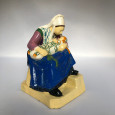Marie-Renée Chevallier-Kervern ( - )
Born in Landerneau in 1902, Marie-Renée Kervern spent her youth between Paris and Amiens, with a spell in Landéda during the first year of the First World War. Between 1921 and 1924, back in Paris, she attended the Arts Déco, the Académie Julian, the Grande Chaumière and the Académie Colarossi. She also studied poster design at the École Art et Publicité.
In 1926 she married Fernand-Paul Chevallier, a young architect, and began to practice engraving. Her first submissions to the Salon des Artistes Français began in 1929, and she became a member of the salon in 1933. In 1936, her husband was appointed Architect of the city of Brest, and it is this connection with her native land that links this artist to the Henriot House. Marie-Renée Chevallier-Kervern's first known piece for Henriot dates from 1939, "Femme de Plonéour-Trez". Her work for the Henriot faience manufactures is essentially composed of statuettes of characters in very colourful costumes. Her taste for Brittany and ethnography permeates all her art, both in ceramics and in engraving. While continuing her work as an artist, in 1951 she became a teacher at the Beaux-Arts de Brest for a little over a decade. In 1955, perhaps influenced by her youth at the Beaux-Arts, Marie-Renée Chevallier-Kervern presented her first non-figurative works. The Brest Museum held a major exhibition of this artist in 1970, and the Gloux Gallery in Concarneau in 1979.
